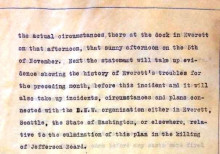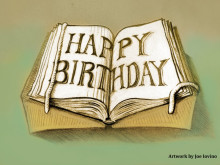Anecdotes and other notes from the U-M Special Collections Research Center.
Beyond the Reading Room

Posts in Beyond the Reading Room
Showing 291 - 300 of 392 items

- Pablo Alvarez
We have recently purchased this very rare Japanese book on surgery for our History of Medicine Collection, which is particularly comprehensive on the history of surgery from the Middle Ages throughout the Renaissance. Since our holdings on this subject mainly focus on Western medicine, this Japanese imprint is a long overdue addition, being an extraordinary witness of one of many cultural exchanges between Japan and Europe from the sixteenth century onward.

- Juli McLoone
Join us this Thursday, November 12th at 4:00 p.m. in the Hatcher Library Gallery for a lecture by donor and adjunct curator Jan Longone on Dining Out: Menus, Chefs, Restaurants, Hotels, & Guidebooks. Jan's lecture will delve into the development, selection process, and contents of this exhibition of the history of the eating out experience. The Exhibit will be on display (Hatcher, 2nd floor) in the Clark Map Library through January 19, 2016.

- Juli McLoone
If you go trick-or-treating this weekend, watch out for witches in candy-filled houses! As Hansel and Gretel learn in this fairy tale, you may get more tricks than treats.

- Julie Herrada
On November 5th, 1916, the town of Everett, WA, witnessed a violent confrontation between a citizens’ militia hostile to labor unions and a group of Industrial Workers of the World members sailing into the town’s port to support local workers on strike. The Labadie Collection has secured a new set of archival documents about the Everett Massacre to be available to researchers.

- Pablo Alvarez
We just hosted our annual donors' reception in the newly renovated space of the Taubman Library last Thursday! As always, it was a great opportunity to express our gratitude to all our friends for having supported the University of Michigan Library throughout the years.

- Kate Foster Hutchens
Four years after the retirement of the paper callslip, the Special Collections Library's Reading Room experience has changed quite a bit...

- Juli McLoone
The Special Collections Library recently opened a new exhibit in the Clark Library (2nd floor Hatcher), entitled Dining Out: Menus, Chefs, Restaurants, Hotels, & Guidebooks. Curated by Jan Longone, adjunct curator and donor of the Janice Bluestein Longone Culinary Archives (JBLCA), this exhibit celebrates the history of the eating out experience.

- Karmen Hall Beecroft
Based on her experiences as pastry chef for the Appeldore House resort, "Miss Parloa," as she came to be known to her students and readers, published her first work, The Appeldore Cook Book, in 1872. Over the course of her lifetime, Maria Parloa would go on to found a two cooking schools, publish nine more books, and endorse a variety of culinary products. Miss Parloa stood out from her contemporaries both because of her savvy business acumen and her emphasis on home economics.

- Pablo Alvarez
In a previous post, I argued that we must judge a book by its cover because the design of an early binding can tell us much about the social status of its former owner. Now, I would like to argue that we can learn a lot about early printing history by examining the preliminary pages of a book.

- Athena Jackson
Don't miss this exhibit opening in Hatcher Library's Audubon Room until December 17th. Read more to learn about associated events.
Audubon Room Hours: Monday-Friday 8:30 am to 7 pm, Saturday 10 am to 6 pm, Sunday 1 pm to 7 pm
Audubon Room Hours: Monday-Friday 8:30 am to 7 pm, Saturday 10 am to 6 pm, Sunday 1 pm to 7 pm